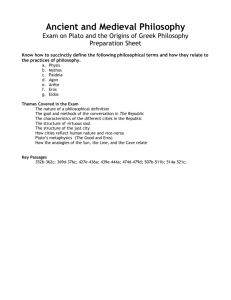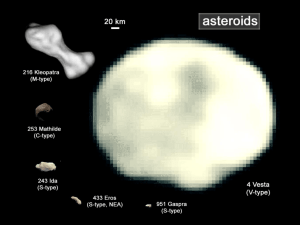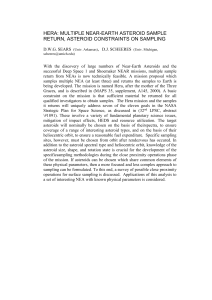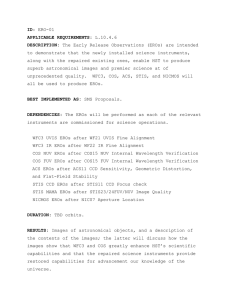L Linear Structures on Eros and Other Small Bodies
advertisement
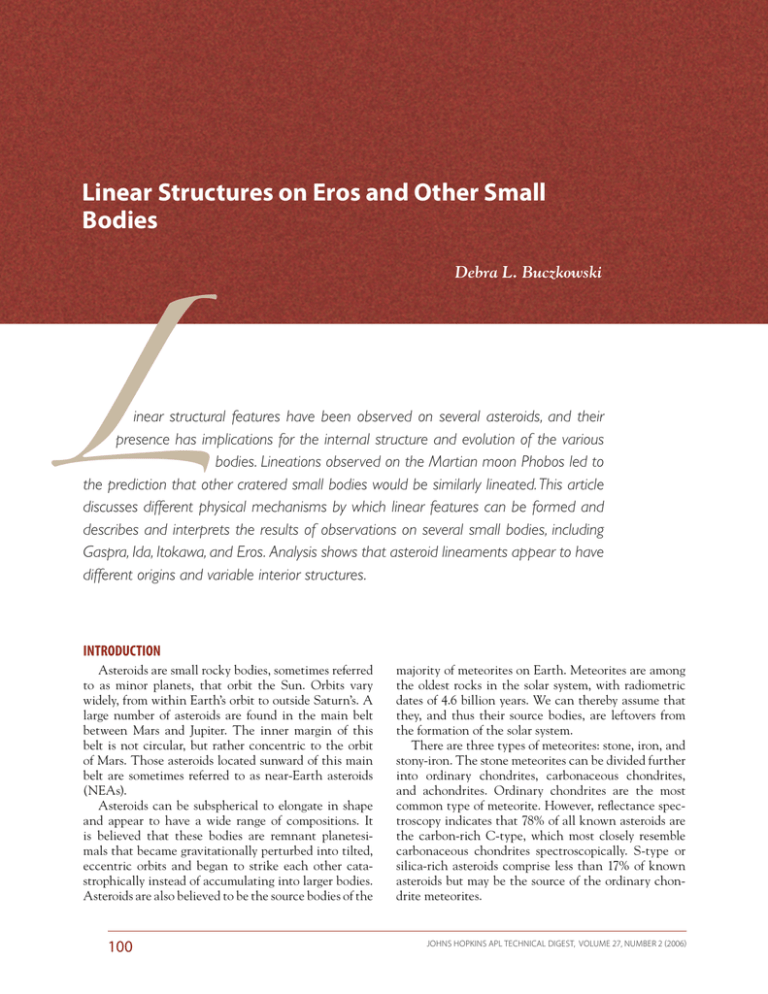
D. L. BUCZKOWSKI L Linear Structures on Eros and Other Small Bodies Debra L. Buczkowski inear structural features have been observed on several asteroids, and their presence has implications for the internal structure and evolution of the various bodies. Lineations observed on the Martian moon Phobos led to the prediction that other cratered small bodies would be similarly lineated. This article discusses different physical mechanisms by which linear features can be formed and describes and interprets the results of observations on several small bodies, including Gaspra, Ida, Itokawa, and Eros. Analysis shows that asteroid lineaments appear to have different origins and variable interior structures. INTRODUCTION Asteroids are small rocky bodies, sometimes referred to as minor planets, that orbit the Sun. Orbits vary widely, from within Earth’s orbit to outside Saturn’s. A large number of asteroids are found in the main belt between Mars and Jupiter. The inner margin of this belt is not circular, but rather concentric to the orbit of Mars. Those asteroids located sunward of this main belt are sometimes referred to as near-Earth asteroids (NEAs). Asteroids can be subspherical to elongate in shape and appear to have a wide range of compositions. It is believed that these bodies are remnant planetesimals that became gravitationally perturbed into tilted, eccentric orbits and began to strike each other catastrophically instead of accumulating into larger bodies. Asteroids are also believed to be the source bodies of the 100 majority of meteorites on Earth. Meteorites are among the oldest rocks in the solar system, with radiometric dates of 4.6 billion years. We can thereby assume that they, and thus their source bodies, are leftovers from the formation of the solar system. There are three types of meteorites: stone, iron, and stony-iron. The stone meteorites can be divided further into ordinary chondrites, carbonaceous chondrites, and achondrites. Ordinary chondrites are the most common type of meteorite. However, reflectance spectroscopy indicates that 78% of all known asteroids are the carbon-rich C-type, which most closely resemble carbonaceous chondrites spectroscopically. S-type or silica-rich asteroids comprise less than 17% of known asteroids but may be the source of the ordinary chondrite meteorites. Johns Hopkins APL Technical Digest, Volume 27, Number 2 (2006) LINEAR STRUCTURES ON EROS AND OTHER SMALL BODIES Theoretically, the density of an asteroid can be a way of determining its composition. An asteroid density close to 5 g/cm3 should indicate a stony-iron composition, while a density closer to 3.3 g/cm3 should be more consistent with an ordinary chondrite. However, the densities of the S-type asteroids visited to date are all less than 3.3 g/cm3. This density discrepancy may be due to the internal structure of the asteroids. Assuming that an asteroid has the same density as a corresponding meteorite requires that the asteroid be a solid body. However, there are four states of asteroid structural modification1: completely coherent, coherent but fractured, heavily fractured (e.g., Refs. 2 and 3), and rubble pile (e.g., Refs. 4–6). A rubble pile’s density would be considerably less than that of a solid body with a similar chemical composition: as low as 3.5 g/cm3 for a stony-iron and perhaps 2.5 g/cm3 for an ordinary chondrite. Thus, the density of an asteroid can also be a measure of its internal structure. If the bulk density of an S-type asteroid is lower than the measured density of comparable ordinary chondrite meteorites (≈3.3 g/cm3), it indicates that the asteroid has a high porosity inconsistent with a completely coherent asteroid.7 However, the presence of long structural features on the surface of the asteroid indicates a significant internal strength inconsistent with a rubble pile. A number of different types of linear structural features, including grooves, fractures, troughs, and ridges (Fig. 1), have been observed on a number of asteroids (e.g., Refs. 8–10). Determining Figure 1. Examples of different lineation morphologies on Eros. Arrows point to features: (a) grooves (image 143673751, res. 9.48 m/p), (b) a flat-floored trough (image 134011958, res. 4.76 m/p), (c) pit chains (image 135344864, res. 4.91 m/p), (d) a ridge (image 131011232, res. 9.91 m/p; courtesy of JAXA), and (e) shallow troughs (image 131034292, res. 9.18 m/p). Johns Hopkins APL Technical Digest, Volume 27, Number 2 (2006) 101­­­­ D. L. BUCZKOWSKI how these features formed yields information about the nature and history of the asteroid. (See the section on Eros later in this article for a fuller discussion of these features.) MODELS FOR LINEATION FORMATION Decades ago, linear structural features were discovered on the Martian moon Phobos in Viking orbiter imagery (Fig. 2a). Thomas and Veverka11 suggested that the grooves on Phobos were most likely the result of the large impact that formed Stickney crater, with which the majority of the grooves are associated. They also predicted that similar lineaments would be observed on other small cratered bodies, a reasonable assumption given the natural tendency for craters to possess radial fractures in the laboratory (e.g., Ref. 12) and on the planets (e.g., Ref. 13). This prediction was realized when images of asteroids began to be returned to Earth. However, the addition of new data also led to new models for the formation of the asteroid lineations. Formation by Impact Numerical calculations indicate that impacts into asteroids could be responsible for the formation of fractures. Axisymmetric calculations of an impact that would generate a Stickney-sized impact in a Phoboslike ellipsoid predict sizes of spall that compare favorably with the spacing of grooves and fractures seen on Phobos.14 In other numerical calculations where impacts into Ida, a main belt asteroid (Fig. 2b), have been considered, Asphaug et al.15 indicated that fractures can be generated far from the impact site. Indeed, a 3-D simulation of the formation of a large crater at one elongate end of Ida shows fracturing as far away as its antipode, where grooves have been observed on the asteroid.8 In this last study, calculations also indicated that impacts into the flat portion of an elongate ellipsoid generate circumferential fractures around the edge of the asteroid perpendicular to the impact normal; impacts on the curved ends of the asteroid result in fracturing mainly at the antipode. These calculations assume extremely Figure 2. (a) Mosaic of three images of Phobos taken by the Viking 1 orbiter at Mars on 19 October 1978. The large crater in the upper left is Stickney. Arrows points to lineations. (b) Mosaic of images of Ida and its satellite Dactyl taken by the Galileo spacecraft on 28 August 1993 while on its way to Jupiter. (c) Mosaic of the highest-resolution images of Gaspra (54 m/pixel) taken by the Galileo spacecraft on 29 October 1991 while on its way to Jupiter. Arrows point to lineations. (d) Image of Itokawa taken by the Hayabusa spacecraft on 4 October 2005. Note that the scale is significantly different from the other asteroids. (Release 051101-2 ISAS/JAXA). 102 Johns Hopkins APL Technical Digest, Volume 27, Number 2 (2006) LINEAR STRUCTURES ON EROS AND OTHER SMALL BODIES simplified asteroid shapes and modeled “asteroids” that are physically homogeneous. Fabric Inherited from a Parent Body Another hypothesis suggests that the lineated small bodies are in fact fragments of larger parent bodies, and it is on these precursor planetary bodies that the lineations actually formed. Two large-scale lineations on Eros—the Rahe Dorsum ridge and the shallow troughs of Calisto Fossae—were found by Thomas et al.16 to be coplanar, with a large flat region (the southern “facet”) on one end of the asteroid (Fig. 3). They determined the unit normal, or pole (Fig. 4), of a plane described by a combination of Rahe Dorsum and Callisto Fossae and compared it to the pole of the plane described by the southern facet of Eros. The two poles are roughly the same, and so Thomas et al. suggested that the three features represented parallel planes indicative of a preexisting structure throughout most of the asteroid, consistent with a fabric inherited from a parent body. Downslope Scouring An alternate hypothesis for the formation of grooves on Phobos is scouring by rolling boulders (e.g., Refs. 17 and 18), but it was determined10 that downslope scouring could not be the primary cause of the globally distributed lineaments on Eros. However, boulders have been identified as being associated with the lineations on Itokawa and are believed to be the cause of their formation. Figure 4. (a) Cartoon of the northern hemisphere of Eros showing the pole (unit normal) of a plane through the asteroid. (b) Graphical description of the coordinates of the pole (or unit normal) of a plane. The shaded box represents the equatorial x-y plane through Eros, while the z-axis represents the spin axis of the asteroid. is the angular distance from x toward y, and is the angle from the x-y plane toward the z-axis. Thermal Stresses Figure 3. Cartoon of 433 Eros showing the location of certain large-scale features, the southern “facet,” and the orientation of the Eros coordinate system. Johns Hopkins APL Technical Digest, Volume 27, Number 2 (2006) It has also been suggested that some lineaments could be the result of thermal stresses.19 The thermal stress model for lineament formation invokes longterm secular changes in the daily/yearly average surface temperature of an NEA as it first moves from the asteroid belt into the inner solar system and then wanders around the near-Earth region.19 Expected expansion and subsequent contraction of the asteroid could lead to observed features whose orientations significantly depend on the shape of the asteroid. 103­­­­ D. L. BUCZKOWSKI ASTEROIDS WITH LINEATIONS Gaspra The first asteroid flyby was of the S-type 951 Gaspra on 29 October 1991 by NASA’s Galileo spacecraft on its way to Jupiter. Gaspra is an extremely angular and nonspherical asteroid, with an average radius of 6.1 km. There are planar surfaces and evidence of surficial cracks, both perhaps due to impacts. Strangely, Gaspra is covered with only small craters. Essentially no medium or large craters exist, as is expected given the asteroid belt’s high cratering rate. Either Gaspra’s surface is very strong, perhaps made of metal, or very young. Grooves are visible in the highest-resolution images of Gaspra (Fig. 2c). The linear depressions are commonly pitted in appearance and can extend up to 2.5 km long and as much as 400 m wide.8 The pitted nature of the grooves are theorized to indicate preexisting fractures or troughs that were covered by a regolith of impact-pulverized rock that may now be draining into the underlying structure (e.g., Refs. 20–22). The orientation of the grooves is consistent with the orientation of facets in the asteroid’s shape identified by Thomas et al.23 The combined groove data led Veverka et al.8 to suggest that Gaspra is most likely a coherent fragment of a precursor body rather than a rubble pile. Itokawa From Earth-based observations, 25143 Itokawa is believed to be an S-type asteroid (Fig. 2d). Radar imaging by NASA’s Goldstone Station revealed a somewhat elongate shape and a 12.5-h rotation period. Hayabusa, which went into orbit around Itokawa on 12 September 2005, has confirmed these findings and also indicates that Itokawa is a contact binary formed by two or more small asteroids that have gravitated toward each other and stuck together. The asteroid was found to have a bulk density of 1.9 g/cm3 and a bulk porosity of 40%.24 There is a surprising lack of impact craters on Itokawa, which has a very rough surface studded with boulders (Fig. 4d). While the density of Ida could indicate that it is not a completely coherent asteroid, Itokawa is the first visited asteroid to actually look like a rubble pile. Despite its appearance, linear structures have been identified on Itokawa. However, these lineations have been interpreted to be the result of boulder movement on the surface of the asteroid25 and do not require a coherent interior. Eros 433 Eros is one of the most elongated asteroids, a potato-shaped body 33 × 13 × 13 km (Fig. 5). It was the first NEA discovered and its size qualifies it as one of only three NEAs with mean diameters above 10 km. A member of the NEA group known as the Amors, Eros’ Ida Galileo also flew by 243 Ida (Fig. 2b) on 28 August 1993. Ida, like Gaspra, is an S-type asteroid. Unlike Gaspra, Ida has a satellite named Dactyl, whose existence allowed scientists to determine Ida’s mass using Dactyl’s orbital period and Kepler’s third law of motion. Ida’s bulk density was then constrained to 2.0–3.1 g/cm3, strongly favoring an ordinary chondrite composition with some internal void space. Color images of Ida indicate that areas of small, deep craters are less red than the older, undisturbed surfaces and show prominent absorption bands of pyroxene and olivine. These characteristics are also compatible with ordinary chondrites. Grooves on Ida are generally continuous linear features that extend up to 4 km long but are commonly <100 m wide.9 Morphologically, the grooves are similar to those on Gaspra and Phobos. There is no obvious orientation of the grooves relative to craters on the asteroid. However, a numerical simulation where impacts into Ida were considered15 indicated that the formation of a large impact crater (Vienna Regio) at one elongate end of the asteroid could cause fracturing as far away as its antipode, where grooves have been observed on the asteroid.8 Sullivan et al.9 concluded that the morphology of the grooves on Ida indicates that they are the surface regolith expression of fractures in a more coherent internal body overlain by a surface regolith. 104 Figure 5. Mosaic of the northern hemisphere of Eros taken by the NEAR-Shoemaker spacecraft (images 127275100, 127275164, 127275246, 127275310, 127275374, 127275456, 127275520; res. ≈27 m/pixel). Arrows point to the Rahe Dorsum ridge. Johns Hopkins APL Technical Digest, Volume 27, Number 2 (2006) LINEAR STRUCTURES ON EROS AND OTHER SMALL BODIES orbit crosses Mars’ path but does not intersect that of Earth. The asteroid follows a slightly elliptical trajectory, circling the Sun in 1.76 years at an inclination of 10.8° to the ecliptic. Because of its repeated close encounters with Earth, Eros has been an important object historically for refining the mass of the Earth–Moon system and the value of the astronomical unit. There has been more than a century of ground-based study of Eros, which makes it the best-observed and most comprehensively studied NEA in the solar system. The Near-Earth Asteroid Rendezvous (NEAR)Shoemaker spacecraft, built and operated by APL for NASA, orbited 433 Eros for a year from 2000 to 2001. The NEAR Multi-Spectral Imager (MSI) collected tens of thousands of high-resolution images. This global, high-resolution imagery has allowed the most in-depth study of lineations on any asteroid to date. Buczkowski et al.26 created a global database of all Eros lineaments to better understand the global distribution of these features and the interior structure of the asteroid. They mapped 2141 lineations, ranging up to tens of kilometers in length, on 180 high-resolution (5–11 m/pixel) images of Eros (Fig. 6). The lineaments were mapped directly on a 22,540-plate Eros shape model (where each of the plates is of approximately equal area). Although some regions of Eros show almost no visible impact craters,27 lineations at a number of different scales are ubiquitous on its surface. Lineament types present on Eros include shallow grooves, flat-floored troughs, pit chains, and ridges (Fig. 1). Grooves are characterized as shallow, v-shaped gashes and are most likely the result of simple fracturing of Eros’ surface, or perhaps the surface representation of larger fractures whose distinct edges have been muted by burial under regolith and crater ejecta. Troughs are wider than grooves and have distinct walls and floors; they could be the result of reactivation of grooves or fractures, perhaps by a later impact, causing further widening of existing cracks. Pit chains are linear assemblages of small depressions, theorized to be grooves or troughs that were covered by regolith that may now be draining into the underlying structure (e.g., Refs. 20–22). Ridges are linear topographic highs, as determined by lighting angle and/or topographic data, and are probably the surface representation of thrust faulting under a compressive state of stress. Whether the linear features observed on Eros are due to impact events or are the surface expression of a preexisting internal fabric, the presence of large-scale structures seems to indicate that the asteroid is, for the most part, a coherent body. However, the density of Eros is 2.6 g/cm3 (Ref. 7), suggesting significant porosity.1 Figure 6. All Eros lineations as mapped in POINTS shown on six orientations of the Eros shape model: (a) western hemisphere, (b) eastern hemisphere, (c) northern hemisphere, (d) southern hemisphere, (e) tail, (f ) nose, (g) pole plot. Johns Hopkins APL Technical Digest, Volume 27, Number 2 (2006) 105­­­­ D. L. BUCZKOWSKI Buczkowski et al.26 grouped the mapped lineations into lineament sets according to location and orientation. Some lineament sets are clearly related to specific impact craters, whereas others have no obvious relationship to impact events but are found globally and may be related to interior structures. It is not obvious on a nonspherical body whether lineaments are associated with each other in a systematic way indicative of internal structure. However, because the Eros lineations were mapped directly onto the shape model, they have a 3-D component and can be modeled to define planes that cut through the asteroid. The unit normal of these planes (Fig. 4) yields a pole that can be compared to the poles of the entire lineament data set. Buczkowski et al.26 compared the pattern of these lineament sets to impact crater location and to models of interior configuration and structure as well as cratering mechanics. Lineaments radial to 10 of Eros’ 37 named craters and 3 unnamed craters were identified. Given their orientation relative to the craters (Fig. 7), these lineaments were likely formed as a direct result of an impact event. No obvious correlation exists between crater diameter or location and the occurrence of radial lineations on Eros. Most of the craters with radial Figure 7. Radial lineations as mapped in POINTS shown on different orientations of the Eros shape model. The bottom image shows only Psyche lineations for clearer viewing, but nearby craters with radial lineations are labeled. Rose diagrams show lineament orientation binned to 15° and are scaled to the number of lineaments per bin. 106 Johns Hopkins APL Technical Digest, Volume 27, Number 2 (2006) LINEAR STRUCTURES ON EROS AND OTHER SMALL BODIES lineations are among the largest of all the Eros impact craters, but there are multiple craters in the largest 30% that do not have radial lineations, while several of the smallest craters do.26 Eight of the 13 craters with associated radial lineations are located at the ends of the elongate asteroid.26 There is some correlation between the presence of radial lineations and the volume of large ejecta blocks per unit area, a proxy for the low-velocity ejecta from the Shoemaker impact.28 A majority of the craters with radial lineations occur in regions of thin Shoemaker ejecta, implying that other Eros impact craters could have radial lineation sets that are simply buried. However, many of the radial lineations occur in areas of high ejecta block volume, perhaps indicating that these impacts are younger than the Shoemaker impact. The primary set of lineations on Eros, called the set 1 lineations by Buczkowski et al.,26 lie in planes that are roughly aligned with the plane defined by the prime meridian of the asteroid (Fig. 8a). Several of the 143 Figure 8. Set 1 (a) and set 2 (b) lineations shown on six orientations of the Eros shape model. Below are plots of the poles to the planes described by the set 1 and set 2 lineations. Poles are weighted by the length of the lineament. Strong clustering of poles indicates that the planes are parallel. Johns Hopkins APL Technical Digest, Volume 27, Number 2 (2006) 107­­­­ D. L. BUCZKOWSKI globally distributed lineations are extremely long, up to tens of kilometers, and needed to be mapped over multiple MSI images. Poles for this set cluster at 0° latitude and 90° longitude, with a mean standard deviation of only 4.2 m and a correlation coefficient R2 of 0.998, suggesting that there is a preferred orientation for these lineaments.26 This pole is perpendicular to the rotation axis of the asteroid and roughly aligned with the Pysche and Himeros craters (Fig. 3), which lie on the equator. The lineations in set 1 are consistent with the pattern expected from fragmentation due to impact on the long side of an ellipsoid target,15 and Buczkowski et al.26 thus inferred that these lineations were formed as a result of the Pysche and/or Himeros impacts. Another set of lineations, identified as set 2, is found encircling Eros from ≈170° to 240°W longitude (Fig. 8b). There are 68 lineations in this set: 38 grooves, 3 troughs, 6 pit chains, and 21 with an unresolved morphology. The pit chains correspond to a region of moderate Shoemaker ejecta volume.27 The poles for this set cluster tightly at around 30° latitude and 130° longitude, with a mean standard deviation of 40.6 m and an R2 of 0.997, inferring a preferred orientation. However, these poles do not obviously follow any predictions of models of lineation formation by impact. Buczkowski et al.26 suspected that these lineations represent a preexisting internal structure. Thermal stresses from the expected expansion and subsequent contraction of the asteroid could lead to observed features whose orientations significantly depend on the shape of Eros, but in general are predicted to trend east–west at the poles and north–south at the lower latitudes.19 Some lineations on Eros are observed to be consistent with formation by thermal stresses,26 but an in-depth investigation has yet to be performed. Downslope scouring is not believed to be a primary cause of the globally distributed lineaments on Eros. Prockter et al.10 found only a few grooves on Eros that are associated with boulders, mostly in the interior of craters. DISCUSSION The interpretation of the various lineations can have implications for our knowledge of the interiors of asteroids and our models of asteroid formation and modification. In particular, the intensive mapping and analysis of the Eros lineations yield important implications for the interior and formation history of that particular asteroid. Buczkowski et al.26 did not find set 2 lineations globally on Eros (Fig. 9). These lineations are only found in a small region of Eros, the so-called tail, from ≈170° to 240°W longitude in both the northern and southern hemispheres. Interestingly, this region is outside the scope of the preexisting planar structure described by 108 Figure 9. Cartoon depicting a single shard history of Eros. Dashed lines represent fracturing, not shock waves. (a) Eros within a larger parent body. Craters are shown for orientation purposes. (b) Impacts on the parent body create the two planar fabrics, but no impact crater on what will be Eros. The orientation portrayed could explain why the Thomas et al.16 fabric (dashed planes, large arrow) covers 22 km of the asteroid while the set 2 fabric (dotted lines, small arrow) is only present on the “tail” of Eros. (c) The Eros parent body breaks apart, leaving the asteroid as a single shard. (d) The set 1 lineations (bold dashed lines) are formed during the Psyche or Himeros (not shown) impact event. Thomas et al.,16 who concluded that a planar structure extends at least 22 km along the length of Eros, from the middle of Rahe Dorsum to the western end of Calisto Fossae. The planar set 2 lineations are not in the same plane as the Thomas et al. planar structure. Perhaps more important, the planar set 2 lineations occur “tailward” of Calisto Fossae; they are not in the section of Eros where Thomas et al. observed planar structure. If the planar fabric is indeed a remnant of structure within a parent body, then the presence of a completely different planar fabric in the Eros tail could imply that its tail has a different parent body from the rest of it, or that it is a piece of a larger Eros that has been “relocated” to the end of the asteroid. Buczkowski et al.26 discuss two of the possible scenarios for the formation history of Eros; unfortunately, neither scenario fully explains the observed lineation sets. In the first scenario Eros is a single, coherent shard, although heavily fractured. However, there would have to be some explanation of how the two planar fabrics could be so regionally localized. The Eros tail would have Johns Hopkins APL Technical Digest, Volume 27, Number 2 (2006) LINEAR STRUCTURES ON EROS AND OTHER SMALL BODIES to have undergone a different stress history than the rest of the asteroid. In one possible set of circumstances in which this scenario could work, Eros begins in the core of a parent body (Fig. 9a). Impacts striking the surface of the parent body fracture different regions of Eros’ core (Fig. 9b). With the destruction of the parent body, the Eros fragment retains the history of parent body fracturing in its structural fabric (Fig. 9c). A new set of fractures (set 1 lineations) forms as a result of the impact, creating Psyche or Himeros (Fig. 9d). In the second scenario Eros is a contact binary. The tail section and the main body of the asteroid are different fragments of the parent body (Fig. 10a). Impacts striking the surface of the parent body fracture different regions of what will become Eros (Fig. 10b). The parent body is destroyed, but the Eros fragments retain the history of parent body fracturing in their structural fabric (Fig. 10c). The tail fragment accretes onto the main body of Eros (Fig. 10d). Since the set 1 lineations cross both of Eros’ main body and tail they would have to had been formed after the tail and main body came into contact. These new fractures form as a result of the impact of Psyche and/or Himeros (Fig. 10e). As discussed earlier, the set 1 lineations could have been formed by the impact of Psyche or Himeros; the lineations are roughly circumferential to the craters while the poles are oriented perpendicularly (Fig. 8a). However, Psyche and Himeros are two of the largest craters on Eros; their impacts must have had significant energy. It seems possible that an impact large enough to create circumferential and radial fractures would have been large enough to push the tail apart from the rest of Eros if it were a binary as opposed to a coherent asteroid. Further impact modeling is needed to determine if any of these impacts could strike a contact binary asteroid with enough force to cause fracturing in both components without forcing them apart. CONCLUSIONS Asteroid lineaments appear to have several different origins and indicate variable interior structures. The lineations on Ida and some of the lineations on Eros appear to be due to impact, but many lineaments on the other small bodies visited by spacecraft have no obvious relationship to impact craters. Lineations on Gaspra indicate a fabric in a coherent asteroid inherited from a parent body, as are many linear structures on Eros. These results are consistent with previous suggestions that Gaspra and Eros are fragments of larger parent bodies. The presence of long structural features on the surface of these asteroids suggests a significant internal strength, despite low density values that indicate high porosity. Lineations on Itokawa are associated with boulders and are consistent with the excavation of regolith by boulder movement on a rubble pile asteroid. Thus it becomes clear that determining how linear features formed on these asteroids yields information about the nature and history of the asteroid itself. References 1Wilkison, Figure 10. Cartoon depicting the potential history of a contact binary Eros. Dashed lines represent fracturing, not shock waves. (a) Two Eros fragments as part of a larger parent body. ( b) Impact on the parent body creates a planar fabric in both pieces of Eros. The orientation portrayed is the Thomas et al.16 fabric. (c) The Eros parent body breaks apart, leaving the asteroid as two shards. (d) The two shards come in contact, forming a binary. (e) Psyche or Himeros (not shown) impact creates the set 1 lineations (bold dashed lines). Shock waves cross the contact of the two individual fragments without pushing them apart. Johns Hopkins APL Technical Digest, Volume 27, Number 2 (2006) S. L., Robinson, M. S., Thomas, P. C., Veverka, J., McCoy, T. J., et al., “An Estimate of Eros’s Porosity and Implications for Internal Structure,” Icarus 155, 94–103 (2002). 2Chapman, C. R., “Asteroid Collisions, Craters, Regoliths and Lifetimes,” in NASA Conf. Publ. 2053, pp. 145–160 (1978). 3Davis, D. R., Chapman, C. R., Greenberg, R., Weidenschilling, S. J., and Harris, A. W., “Collisional Evolution of Asteroids: Populations, Rotations and Velocities,” in Asteroids, T. Gehrels (ed.), Univ. of Arizona Press, Tucson, pp. 528–557 (1979). 4Hartmann, W. K., “A Special Class of Planetary Collisions: Theory and Evidence,” in Proc. Lunar and Planetary Science Conf. 10, pp. 1897–1916 (1979). 5Asphaug, E., Ostro, S. J., Hudson, R. S., Scheeres, D. J., and Benz, W., “Disruption of Kilometer-sized Asteroids by Energetic Collisions,” Nature 393, 437–440 (1998). 6Wilson, L., Keil, K., and Love, S. J., “The Internal Structures and Densities of Asteroids,” Meteor. Planet. Sci. 34, 479–483 (1999). 7Yeomans, D. K., Antreasian, P. G., Barriot, J.-P., Chesley, S. R., Dunham, D. W., et al., “Radio Science Results During the NEARShoemaker Spacecraft Rendezvous with Eros,” Science 289, 2085– 2088 (2000). 109­­­­ D. L. BUCZKOWSKI 8Veverka, J., Thomas, P., Simonelli, D., Belton, M. J. S., Carr, M., et al., “Discovery of Grooves on Gaspra,” Icarus 107, 399–411 (1994). 9Sullivan, R., Greeley, R., Pappalardo, R., Asphaug, E., Moore, J. M., et al., “Geology of 243 Ida,” Icarus 120, 119–139 (1996). 10Prockter, L., Thomas. P., Robinson, M., Joseph. J., Milne, A., et al. “Surface Expressions of Structural Features on Eros,” Icarus 155, 75–93 (2002). 11Thomas, P., and Veverka, J., “Grooves on Asteroids: A Prediction,” Icarus 40, 394–405 (1979). 12Fujiwara, A., and Asada, N., “Impact Fracture Patterns on Phobos Ellipsoids,” Icarus 56, 590– 602 (1983). 13Reimold, W. U., Brandt, D., and Koeberl, C., “Detailed Structural Analysis of the Rim of a Large Complex Impact Crater: Bosumtwi Crater, Ghana,” Geology 26, 543–546 (1998). 14Asphaug E., and Melosh, H. J., “The Stickney Impact of Phobos: A Dynamical Model,” Icarus 101, 144–164 (1993). 15Asphaug, E., Moore, J. M., Morrison, D., Benz, W., Nolan, M. C., and Sullivan, R. J., “Mechanical and Geological Effects of Impact Cratering on Ida,” Icarus 120, 158–184 (1996). 16Thomas, P. C., Prockter, L., Robinson, M., Joseph, J., and Ververka, J., “Global Structure of Asteroid 433 Eros,” Geophys. Res. Lett. 29(10), 10.1029/2001GL014599 (2002). 17Head, J. W., and Cintala, M. J., “Grooves on Phobos: Evidence for Possible Secondary Cratering Origin,” in Reports of the Planetary Geology Program, 1978–1979, NASA Tech. Mem. 80339, pp. 19–21 (1979). 18Wilson, L., and Head, J. W., “Dynamics of Groove Formation on Phobos by Ejecta from Stickney,” Lunar Planet. Sci. 20, 1211–1212 (1989). 19Dombard, A. J., and Freed, A. M., “Thermally Induced Lineations on the Asteroid Eros: Evidence of Orbit Transfer,” Geophys. Res. Lett. 29(16), 10.1029/2002GL015181 (2002). 20Thomas, P. C., Veverka, J., Bloom, A., and Duxbury, T., “Grooves on Phobos: Their Distribution, Morphology and Possible Origin,” J. Geophys. Res. 84, 8457–8477 (1979). 21Horstman, K. C., and Melosh, H. J., “Drainage Pits in Cohesionless Materials: Implications for the Surface of Phobos,” J. Geophys. Res. 94, 12,433–12,441 (1989). 22Wyrick, D. Y., Ferrill, D. A., Morris, A. P., Colton, S. L., and Sims, D. W., “Distribution, Morphology and Origins of Martian Pit Crater Chains,” J. Geophys. Res. 109, 10.1029/2004JE002240 (2004). 23Thomas, P. C., Veverka, J., Simonelli, D., Helfenstein, P., Carcich, B., et al., “The Shape of Gaspra,” Icarus 107, 23–36 (1994). 24Abe, S., Mukai, T., Barnouin-Jha, O. S., Cheng, A. F., Hirata, N., et al., “Density, Porosity and Interior Structure of Asteroid Itokawa by the Hayabusa Mission,” Eur. Planet. Sci. Cong., abs. A-00493, Berlin, Germany (2006). 25Sasaki, S., et al., “Observations of 25143 Itokawa by the Asteroid Multiband Imaging Camera (AMICA) of Hayabusa: Morphology of Brighter and Darker Areas,” abs. 1671, LPSC XXXVII, (CD-ROM), Lunar and Planetary Institute, Houston, TX (2006). 26Buczkowski, D. L., Barnouin-Jha, O. S., and Prockter, L. M., “433 Eros Lineaments: Global Mapping and Analysis,” Icarus (in press, 2007). 27Thomas, P. C., and Robinson, M. S., “Seismic Resurfacing by a Single Impact on the Asteroid 433 Eros,” Nature 436, 366–369 (2005). 28Thomas, P. C., Veverka, J., Robinson, M. S., and Murchie, S., “Shoemaker Crater as the Source of Most Ejecta Blocks on the Asteroid 433 Eros,” Nature 413, 394–396 (2001). The Author Debra L. Buczkowski came to the APL Space Department in 2005 as the Planetary Exploration Group’s postdoctoral researcher and a member of the Associate Professional Staff. She has a Ph.D. in geosciences and an M.S. in geology from the University of Massachusetts, Amherst, and earned a B.A. in astronomy from Boston University. Dr. Buczkowski’s research includes topographic and statistical analyses of quasi-circular depressions and polygonal fractures on Mars, kinematic mapping of Venus, and lineament mapping of Eros. She is also presently involved in CRISM (Compact Reconnaissance Imaging Spectrometer for Mars) mission operations, where her duties include processing of target selection, coordination with other Mars Reconnaissance orbiter instrument targets, and target uplink. Dr. Buczkowski’s e-mail address is debra.buczkowski@jhuapl.edu. Debra L. Buczkowski 110 Johns Hopkins APL Technical Digest, Volume 27, Number 2 (2006)


